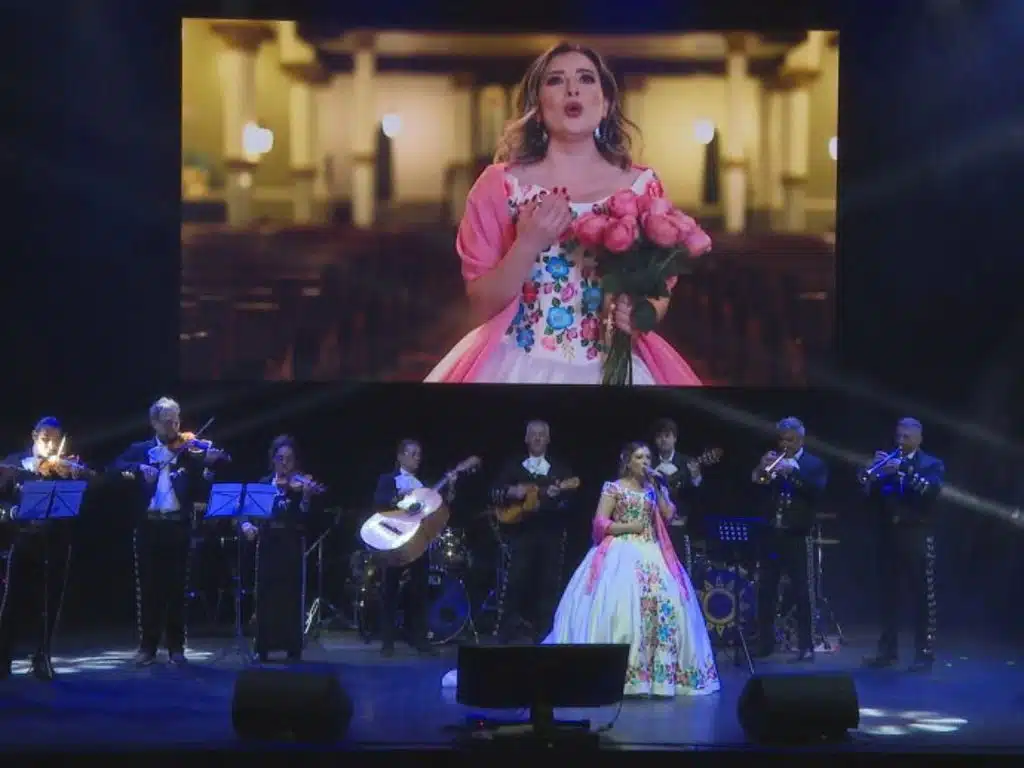Today, the United States still endures the spiritual wound of racism, said director David Michael Warren to a packed movie theater March 30. “So, if we want to end racism, if we want to end prejudice, if we want to end injustice … run to the Eucharist.”
Warren directed and released his 2022 film, “A Place at the Table: African Americans on the Path to Sainthood,” on the “Saintly Six” African American men and women who persevered against the injustices of racism, and whose causes for canonization are ongoing: Venerable Pierre Toussaint (1766-1853), Servant of God Mary Lange (1790-1882), Venerable Henriette DeLille (1812-62), Venerable Augustus Tolton (1854-97), Servant of God Julia Greeley (1833-1918) and Servant of God Sister Thea Bowman (1937-90).
The Arlington diocese’s Office of Multicultural Ministries recently purchased a two-year license to Warren’s 2022 film, which may be obtained by parishes for screenings. Catholic ministry leaders and members throughout the diocese were invited to a viewing of the film at Regal Springfield Town Center March 30. The viewing was sponsored entirely by a grant to the diocese from the Washington-based Black and Indian Mission Office.
“If you were to speak to Mary Lange, if you were to speak to Sister Thea Bowman, if you were to speak to Pierre Toussaint, any of the figures in this film, I think you’d find that their own lives were not about themselves … Their lives were about Jesus,” Warren said. “This film, I hope, is my prayer for unity in the church.”
Bishop Michael F. Burbidge offered a prayer before the film began. “We pray that our hearts are open to receive the message of this movie, to be open to the inspiration of the heroic men and women who have strived so vigorously to be faithful to you and to your Gospel,” he prayed.
The black-and-white film opens with a Gospel choir singing at Blessed Sacrament – St. Joan of Arc Church in New Orleans. The film then cuts to Blessed Sacrament’s pastor, Jesuit Father Charles Andrus, who says, “At this moment, there aren’t any African American saint(s).” While the church has canonized many Black saints, none are from the United States — yet — Father Andrus says.
Catholic speaker and vocations director for the Diocese of Baton Rouge Father Josh Johnson emphasizes the importance of the six canonization causes. “Going to church, I never saw a Black priest, I never saw Black sisters, I never saw any Black Catholics,” he says in the film. “I think sometimes we believe that holiness is ‘not for me.’ ”
Father Johnson recalls a moment when he was asked to address the faculty of a diverse Catholic school. A student had written a racist paper that was screenshotted and went viral. Sitting before the tabernacle in the school chapel, praying for Christ to give him inspiration, Father Johnson notices, “In the chapel, the image of Jesus was white, Joseph was white, St. Michael was white, Mary was white. And the only dark image in that chapel was Satan. And I just remember thinking to myself, ‘What does this communicate?’ ”
The film then delves into the lives of the Saintly Six. Three of the six individuals, Pierre Toussaint, Father Augustus Tolton and Julia Greeley, were enslaved. All six endured racism within their local communities and even within the church. Regardless, they strived to live out the vocations they felt God calling them to — even founding their own religious orders. All possessed a deep love for Christ in the Eucharist, and they served the poor and marginalized despite persecution. Many were daily communicants.
Pierre Toussaint, an enslaved man, worked as a hairdresser in New York City in the 18th century. He devotedly served the widow of his enslaver while raising funds for an orphanage from his work. He later married Juliette Noel, purchased her freedom and adopted the daughter of his deceased sister, Rosalie. Toussaint was a daily Massgoer for 66 years, up until a few months before his death June 30, 1853. He is the only layman buried in St. Patrick’s Cathedral in New York City.
Mother Mary Lange — then called Elizabeth Clarisse Lange — began teaching Black students out of her home in Baltimore in the 1810s. She entered the novitiate and began a school for Black girls in 1829, under the direction of Father James Hector Joubert. She received permission to found her own religious order, the Oblate Sisters of Providence in 1832. Over the decades, Mother Lange and her sisters would face much racism, both culturally and within the church, for their work educating Black children. She died Feb. 3, 1882.
As a young woman, Henriette DeLille gave birth to two sons, but both died very young. During this period of grief, she experienced a religious reversion when she received the sacrament of confirmation at St. Louis Cathedral in New Orleans in 1834. She discerned religious life and began a Christian women’s group for Black women, which eventually became the Sisters of the Holy Family in 1842. She led the order to care for poor and enslaved individuals in New Orleans; they even cared for the sick during the deadly yellow fever epidemic in 1853. After decades of caring for the poor and marginalized, she died of tuberculosis Nov. 16, 1862.
Augustus Tolton was born April 1, 1854, in Missouri. His mother, an enslaved woman, made a daring escape with infant Augustus and her two other children, and ended up in Quincy, Ill. Several benefactors saw to his education, and the priests and religious sisters who educated him recognized his love of God and encouraged him to consider the priesthood. With the help of the local Franciscan friars, Tolton was sent to Rome, where he studied for the priesthood for six years and was ordained. After returning to minister in Quincy, Father Tolton endured much racism, even from several Catholic clergy. He was invited to serve the Black Catholic community in Chicago and made plans to build a church for the community. A few years after the church was built, Father Tolton died from heatstroke July 8, 1897.
Julia Greeley was born around 1833 and was enslaved until 1865, when the Emancipation Proclamation was issued. Greeley worked for a Catholic family in St. Louis for nine years before moving to Denver. Her employer there introduced her to the Catholic faith, and she entered the church in 1880. Greeley was a daily communicant with a strong devotion to the Sacred Heart of Jesus. She devoted her life to helping local families in need, often under the secrecy of nightfall. She distributed materials on the Sacred Heart to all she met, including local firefighters. Greeley joined the Secular Franciscan Order in 1901 and was an active member until her death June 7, 1918, the feast of the Sacred Heart of Jesus.
Sister Thea Bowman — born Bertha Elizabeth Bowman — experienced a profound conversion to the faith at 9 years old while attending Holy Child Jesus Catholic School in Canton, Miss. At age 15, she became the first African American woman to enter the Franciscan Sisters of Perpetual Adoration and was given the name “Sister Mary Thea.” She faced racism during her early years in the order yet persevered. She earned a bachelor’s in English from Viterbo College in La Crosse, Wis., and went on to earn a master’s in English and her doctorate at The Catholic University of American in Washington. She returned to teach at her childhood school and went on to become a prominent Catholic speaker. Bowman addressed the U.S. Conference of Catholic Bishops in 1989, when she gave her famous speech, “What does it mean to be Black and Catholic?” She died from breast cancer the following year, March 30, 1990.
The film concludes with reflections on how the canonizations of the six men and women would impact the church. “To have saints, canonized saints from our community, I think would totally draw so many people to the Eucharist, and that’s what Jesus longs for,” Father Johnson says.
Following the film, Phyllis Johnson, a parishioner of St. Joseph Church in Alexandria and a member of the Mother Mary Lange Guild, said that throughout her life, she has experienced some of the same resistance that Venerable Augustus Tolton experienced. “I think that resonated with me, that regardless of the meanness, regardless of the isolation, regardless of not including us, I’m still going to be Catholic,” she said.
Peter Teye, a member of the diocesan St. Josephine Bakhita Ghanaian Catholic Community, said that prior to the film he had heard a little about the canonization of the six men and women, “but I felt like I needed to know more of the story.”
Teye added that Bowman’s story resonated with him the most. The film included a brief clip of Bowman singing before the USCCB, “Sometimes, I feel like a motherless child,” which moved Teye. “I almost cried,” he said. “I hope all of them become saints, but for her, I sincerely hope she can.”
Find out more
To request the film, contact multicultural ministries at [email protected].




